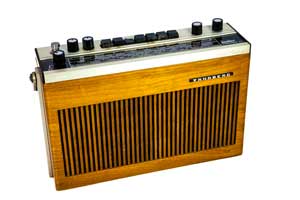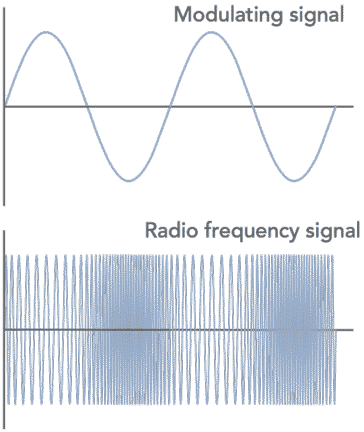Broadcast VHF FM Tutorial & Basics
Details or tutorial about VHF FM broadcasting signals and single formats
VHF FM Broadcasting Tutorial Includes:
VHF FM basics
Pre-emphasis & de-emphasis
Stereo
Frequencies, channels & bands
VHF broadcasting is established in most countries around the globe.
VHF broadcast technology provides excellent fidelity in terms of audio frequency response and background noise of all forms.
As a result of its advantages, VHF FM broadcasting has been widely accepted. Even though digital formats are being introduced, many see no need to migrate because the performance of the analogue FM transmissions is more than adequate.

Beginnings of VHF FM broadcasting
When broadcasting first started in the 1920s amplitude modulation was the form of modulation used. It was the obvious and the easiest way to transmit sound.
However as radio technology developed its shortcomings became more obvious. The long and medium wave bands became more congested, giving rise to interference. Also the static and other background noise meant that high quality transmissions were not feasible.
It had been thought that the key to improving quality was to narrow the bandwidth of the transmission to reduce the amount of interference received. However this also reduced the audio bandwidth that could be transmitted and in addition to this, much noise was still present.
The quest for higher quality transmissions lead to the introduction of wideband frequency modulation. Although the first commercial stations were set up in the USA around 1939, it was not until the 1950s that FM started to become really accepted. It was in 1954 that the BBC announced their intention to start FM broadcasting. Now VHF FM is the accepted medium for high quality transmissions, and stations that use AM on the medium and long wave bands have to work hard to retain listeners who prefer the higher quality of VHF FM.
VHF FM basics
Amplitude modulation, which is the simplest and most obvious form of modulation varies the amplitude of the carrier so that it carries the sound information. Frequency modulation is slightly more subtle and as the name indicates it varies the frequency of the carrier in line with the variations in the modulating audio signal. This as the modulating waveform increases in voltage, so the carrier will swing in one direction and as it decreases it will move in the other direction.

One of the important factors of FM is the degree by which the carrier changes. This deviation is usually expressed in kilohertz variation either side of the centre (no modulation) frequency. Typically a signal may have a deviation of +/- 3kHz if it varies up and down by 3 kHz. There are two main categories on FM. The first is called narrow band FM, and this is where the deviation is relatively small, possibly 5 kHz. This type of transmission is used mainly by VHF / UHF point to point mobile communications. To appreciate the full benefits of FM, wideband FM is used having a greater level of deviation. The standard for broadcasting is +/- 75 kHz. To fully accommodate these transmissions a bandwidth of 200 kHz is used.
The advantage of FM is that as the modulation is carried solely as frequency variations, much noise, which appears mainly as amplitude variations can be discarded in the receiver. Accordingly it is possible to achieve much better noise performance using FM. The upper audio frequency limit is generally taken as 15 kHz for these transmissions. This is quite adequate for most high quality transmissions.
Note on Frequency Modulation, FM:
Frequency Modulation, FM is a form of radio signal modulation where the frequency of the carrier signal is varied in line with the modulating information. It is widely used for many applications from small handheld VHF walkie talkies, to high quality VHF FM broadcast transmissions.
Read more about Frequency Modulation, FM
VHF FM broadcasting standards
In order to ensure that receivers can receive all the stations satisfactorily, that interference levels are reduced and that equipment can be standardised more, there are common standards used by the licencing authorities. Within the USA, the FCC sets the standards, whereas within Europe, ETSI, the European Telecommunications Standards Institute maintains standards that are generally used by the administrations within these regions, and often beyond.
These standards detail the main specifications which equipment should meet. The highlight specifications are detailed below. These are based mainly upon the ETSI figures.
| VHF FM Broadcasting Stdanrds Summary | |
|---|---|
| Parameter | Figures & details |
| Frequency band | 87.5 - 108.0 MHz (USA uses 87.8 - 108.0 MHz) |
| Channel Width | 200 kHz |
| Max deviation | Shall not exceed ±75 kHz |
| Preferred operating frequencies | Multiples of 100 kHz |
| Other channels | Shall be capable of carrying stereo, RDS, SCA, etc |
| Audio subcarrier frequency | 19 kHz |
| Stereo centre frequency | 38 kHz, i.e. 2 x 19 kHz |
| RDS carrier frequency | 57 kHz, i.e. 3 x 19 kHz |
 Written by Ian Poole .
Written by Ian Poole .
Experienced electronics engineer and author.
More Audio Video Topics:
HDMI
SCART
DisplayPort
DVI
Loudspeaker technology
Headphones & earphones
Bluetooth speakers
Stereo sound
Microphones
Audio compact cassettes
Vinyl record technology
Digital radio
DVB television
Return to Audio / Video menu . . .



